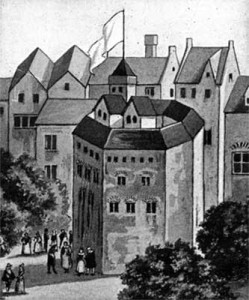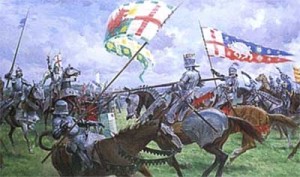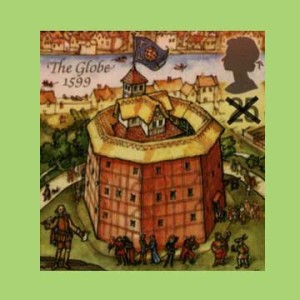Flags fly for plays

This year marks the 450th birthday of William Shakespeare (see last week’s posting for examples of his use of flags in his plays). Besides being a writer, he was a co-owner of the Globe Theatre, located across the Thames River from London. The site used flags to attract play-goers.
The pennants were necessary because communication media were scarce. While the printed word allowed the announcement of plays to be widely known, few people could read. So the playwright needed a simple system to let his fans know when one his works was being mounted and what sort of play it was.
A 1612 document affirms that “each play-house advanceth his flagge in the aire, whither quickly at the waving thereof are summoned whole troops of men, women, and children.”
The theater flags could even announce that a new playhouse was opening. A flag displaying an image of Hercules with the world on his back, for instance, first proclaimed that the newly built Globe was open for business. The theater debuted with a performance of Shakespeare’s “Julius Caesar.”

The flags were color-coded so that potential audience members were alerted to what type of play was being put on:
*White meant a comedy was being enacted, such as “A Midsummer’s Night Dream”;
*Black indicated a tragedy, “Hamlet” perhaps;
*Red signaled a history play, for example “Richard III.”
In a 1919 edition of the script of “Julius Caesar,” Samuel Thurber, the editor, traveled back in time to describe to readers what it was like to go to a new Shakespeare play:

“The front of the stage and the whole center of the theatre is open to the air….We notice that a flag is flying from a short pole on the roof over the stage. This is most important, for it is announcing to the city across the river that this afternoon there is to be a play. It is bill-board, newspaper notice, and advertisement in one; and we may imagine the eagerness with which it is looked for among the theatre-loving populace of these later Elizabethan years. When the performance begins the flag will be lowered to proclaim to all that ‘the play is on.’”
The original Globe burned to the ground in the 17th century. When a replica was constructed in the 1990s, it was faithful to the original’s appearance, right down to the presence of a flagpole.
